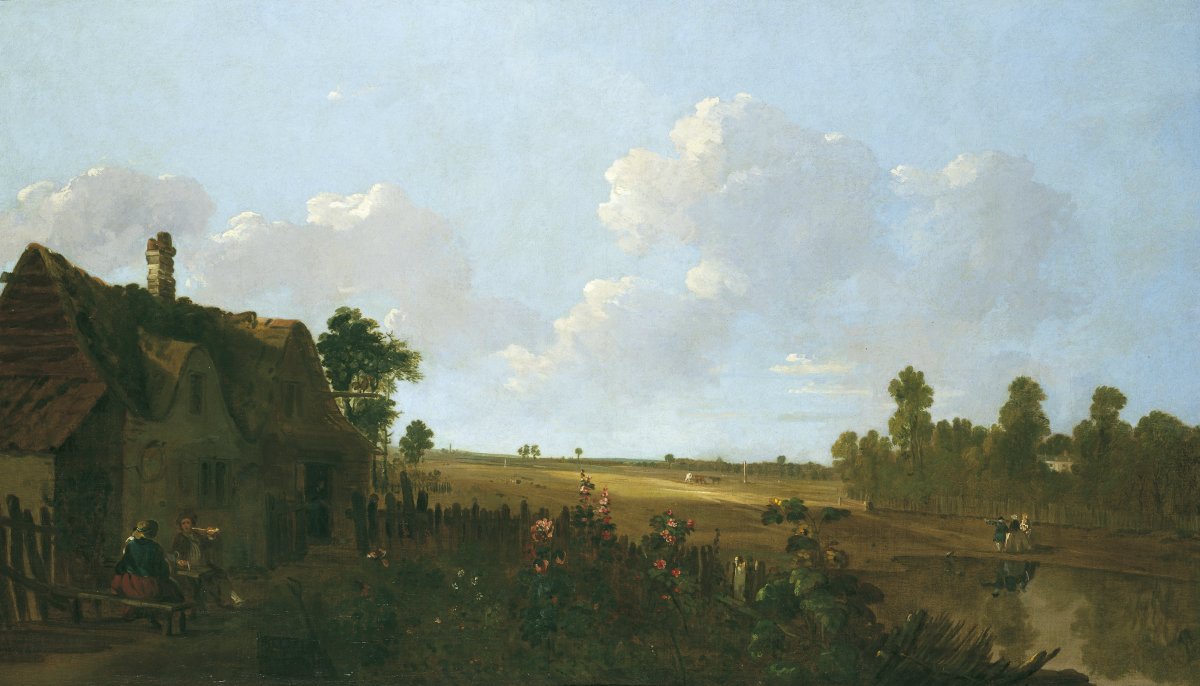The Cock Inn, Cheam Common

-
About the work
- Location
-
Country: Other
City: other locations abroad
This work by 18th-century landscape painter Richard Wilson depicts Cheam Common in Surrey, with the Cock Inn (also known as the Cock Tavern; demolished early 19th century) to the left and a country house, possibly Cheam House, to the right.Wilson painted The Cock Inn, Cheam Common early in his career, in around 1745, a few years before departing for Italy. In a 1982 catalogue for a Tate exhibition of Wilson’s work, art historian David Solkin describes this work as ‘overtly Netherlandish’. He argues that after around 1745 Wilson temporarily abandoned Italianate landscapes in favour of ‘an increased dependence on the landscape tradition of 17th-century Holland’. At that time, there was particular interest in landscapes by Dutch painters, such as Jacob van Ruisdael (1628/9–1682), Meindert Hobbema (1638–1709) and Jan Wynants (1632–1684), among British collectors. Solkin argues that Wilson painted The Cock Inn with this market in mind. The four versions of the painting in existence (in the Tate collection, collection of Lord Brownlow and Winnipeg Art Gallery, Canada) suggest it was his most popular composition.During the mid-18th century Cheam was not a distinguished area. In view of this, it seems surprising that this was such a popular composition. However, Solkin explains the attraction of an undistinguished, public landscape to lesser patrons, who did not own large estates, of which they could commission painted views. As Daniel Defoe remarked in Complete English Tradesman (1738) ‘How many noble seats… do we see erected within a few miles of this city by tradesmen’. By establishing second properties in villages near to London tradesmen were transforming themselves into gentlemen. The notion of a hierarchical, yet contented, social structure within such villages appealed to middle class collectors. This example, which gives a glamorised view of the hierarchy between those of the tavern and those of the country house, separated by a stretch of ‘neutral’ common, confirms and validates the newly enhanced status of the tradesmen, who purchased such paintings. -
About the artist
Richard Wilson was a key figure in the early development of British landscape painting. He worked as a portraitist until the 1750s, when he spent seven years studying in Italy. He trained himself to become a landscape artist in the style of Lorrain and Poussin, whose classical and idyllic landscapes were popular with the English upper classes. Wilson built up a successful landscape practice in London on his return from Italy, but his career declined in the 1770s, in part as a result of his alcoholism and illness.
- Explore
-
Details
- Title
- The Cock Inn, Cheam Common
- Date
- c.1745-1747
- Medium
- oil on canvas
- Dimensions
- height: 84.50 cm, width: 144.50 cm
- Acquisition
- Purchased from Agnew's, May 1980
- Provenance
- Collection of Mr and Mrs Carr of Petersham; from whom purchased by Ronald Lee; with Leggatt Bros. in 1954; collection of Maurice Harold Grant (pseudonym Linesman; born 1872); sold through Christie's, London, 'Important English Pictures' sale, on 18 June 1976 (Lot 112), for £6000; with Agnew's Gallery, London; from whom purchased by the Department of the Environment in May 1980
- GAC number
- 15029